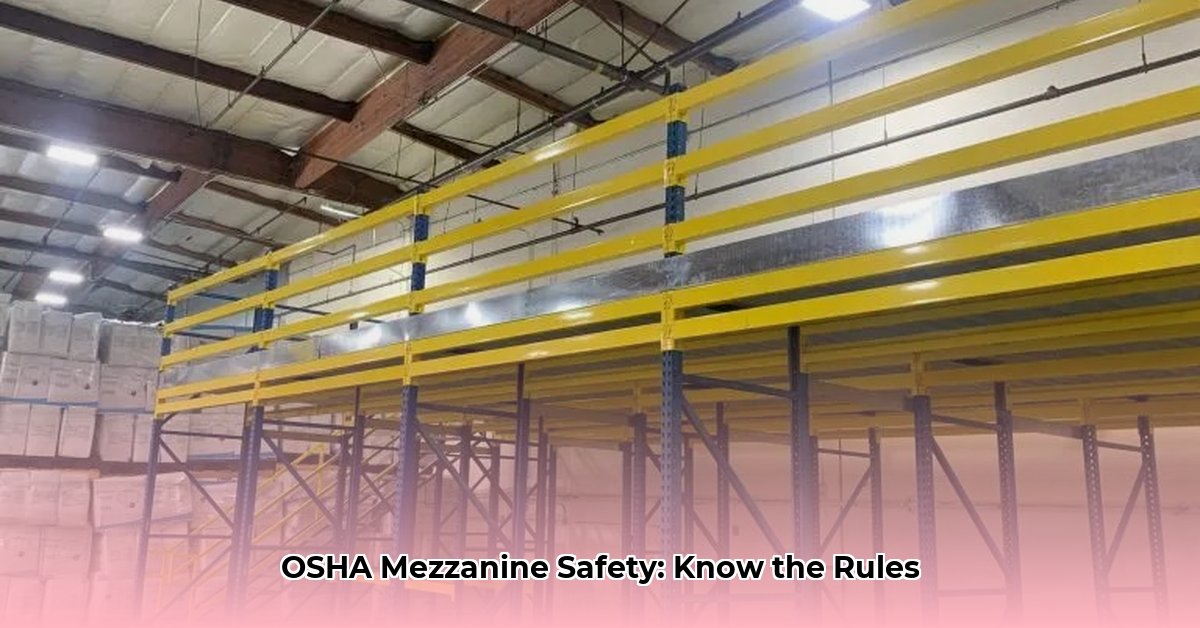Looking to maximize your warehouse space with a mezzanine floor? That’s a great idea! But first, you need to understand the safety regulations. For more detailed information on mezzanine safety, check out this helpful guide: Mezzanine Safety Guide. This guide breaks down OSHA requirements and relevant building codes, offering actionable steps for building, inspecting, and maintaining a safe mezzanine. We’ll walk you through everything from initial design to routine maintenance, helping you avoid costly mistakes and prioritizing the safety of your workers. Plus, we’ll provide expert tips for ensuring your mezzanine remains safe and efficient for years to come. Let’s make sure your mezzanine is both safe and productive!
Understanding OSHA Requirements for Mezzanine Floors: Prioritizing Safety
Mezzanine floors are elevated platforms commonly used in warehouses and factories, offering additional space for storage and operations. However, these structures also introduce potential safety hazards. This section outlines the essential OSHA (Occupational Safety and Health Administration) requirements for mezzanine floors, aimed at protecting your workforce and preventing costly violations. From structural integrity to clear emergency exits, we’ll cover the critical aspects of code adherence and preparedness.
Building a Solid Foundation: Structural Integrity and Load Capacity Considerations
Think of your mezzanine floor as a critical structural component of your facility. It must be capable of supporting anticipated loads, including personnel, materials, and equipment. The International Building Code (IBC) sets specific standards for load-bearing capacity that must be followed. Neglecting these standards can lead to structural failure, creating significant safety hazards. Engaging a qualified structural engineer to design and regularly inspect your mezzanine is highly recommended. These experts have a thorough understanding of relevant codes and can identify potential issues before they escalate. Regular inspections are like routine check-ups, ensuring the long-term safety and stability of your mezzanine floor. Accurately determining load capacity limits and clearly posting them is crucial; exceeding these limits is a primary cause of mezzanine failures.
Preventing Falls: OSHA’s Priority in Elevated Workspaces
Falls are a leading cause of workplace injuries, and OSHA takes them seriously, especially on mezzanine floors. OSHA mandates specific fall protection measures, including guardrails, safety nets, or personal fall arrest systems (PFAS). PFAS are harness systems designed to safely arrest a free fall, minimizing the risk of injury. The regulations detail specific requirements for guardrail height (at least 42 inches), strength (capable of withstanding 200 pounds of force), and spacing (to prevent workers from falling through). These aren’t mere suggestions; they are mandatory requirements. Regular inspections of these safety systems are crucial, acting as the first line of defense against accidents. Damaged or improperly installed equipment can significantly increase the risk of injury. Ensure everything is maintained in optimal condition.
Ensuring Safe Egress: Clear Routes and Emergency Exits
The IBC dictates the number and type of exits required for your mezzanine, depending on its size and occupancy. The number of exits typically depends on the size of the platform (the larger the area, the more exits are required) and the number of personnel working within the area. These exits must be clearly marked with visible signage and remain free of obstructions such as boxes, materials, or equipment. Providing clear, unobstructed escape routes is critical in the event of a fire or other emergency, enabling personnel to evacuate quickly and safely. Planning for worst-case scenarios and regularly reviewing evacuation plans is essential for responsible safety management. Conduct regular emergency drills to ensure personnel are familiar with evacuation routes and procedures.
Understanding Guardrail Guidelines: Specifications for Fall Prevention
Let’s examine the detailed specifications for guardrails, a fundamental aspect of mezzanine floor safety. OSHA outlines the following key requirements:
- Height: Guardrails must be at least 42 inches (106.7 cm) high to prevent accidental falls over the edge.
- Mid-rails: A mid-rail should be positioned approximately halfway between the top rail and the floor to provide added protection and prevent falls through the gap.
- Toeboards: Toeboards (minimum 3.5 inches high) play a crucial role in preventing smaller items from falling to lower levels, protecting workers below.
- Strength: Guardrails must be capable of withstanding a significant impact (typically at least 200 pounds of force) to ensure they can support personnel who may lean against them.
Schedule and perform regular guardrail inspections to ensure ongoing integrity. A well-maintained guardrail system is a safe system. Repair or replace any damaged parts immediately. Delaying repairs can lead to serious accidents.
Maintaining a Safe Environment: Inspection and Maintenance
Regular inspections are not optional but mandatory. Establish a clear inspection schedule and adhere to it diligently. Think of it as preventative maintenance, which is far more cost-effective than addressing major issues later. Meticulously document all inspections. This documentation is a legal requirement, demonstrating your commitment to mezzanine floor safety and providing a record of compliance.
Training Your Team: Knowledge Reduces Workplace Incidents
Employee training is as critical as physical safety measures. Employees must understand fall protection procedures, the proper use of safety equipment, and the location and use of emergency exits. Well-trained workers contribute significantly to a safer work environment. OSHA-compliant safety training programs can significantly impact workplace safety, substantially reducing the risk of accidents. Regular safety training sessions should be a standard operating procedure. This is a valuable investment in your employees’ well-being and your company’s long-term success.
Real-World Scenario: The Importance of Proactive Safety
Consider a documented incident involving a partial mezzanine collapse. The investigation revealed inadequate structural support and a lack of regular inspections. The result was costly repairs, significant downtime, and a near-fatal outcome. This real-world example underscores the critical need for proactive safety measures.
OSHA Compliance Checklist: Key Elements
| Requirement Category | Relevant OSHA Standard(s) (Examples) | Relevant IBC Section(s) (Examples) | Essential Actions |
|---|---|---|---|
| Fall Protection | 1910.23, 1910.28, 1910.29 | Varies by local jurisdiction | Install and maintain approved guardrails, safety nets, and personal fall arrest systems. |
| Structural Integrity | N/A | Varies by local jurisdiction | Conduct regular inspections by a qualified structural engineer and maintain detailed records. |
| Egress | N/A | Varies by local jurisdiction | Ensure adequate, clearly marked, and unobstructed exits. |
| Emergency Procedures | N/A | Varies by local jurisdiction | Develop and practice clear emergency procedures and provide thorough employee training. |
This guide provides a general overview of OSHA requirements for mezzanine floors. However, specific local building and safety codes may include additional requirements. Always verify compliance with local authorities to ensure a safe and code-compliant environment. Prioritizing worker safety involves not only meeting compliance standards but also fostering a culture of care and responsibility in the workplace.
Ensuring OSHA and IBC Compliance for Mezzanine Floor Fall Protection Systems
Key Takeaways:
- Mezzanine safety depends on a robust fall protection system.
- OSHA 1910.29 and IBC building codes are essential resources.
- Regular, documented inspections are critical for ongoing safety.
- Comprehensive employee training is essential.
- Proactive planning minimizes risks and reduces costs.
Understanding Regulations for Workplace Safety
Complying with mezzanine safety standards is a legal mandate. Critical regulations to understand for ensuring OSHA and IBC compliance for mezzanine floor fall protection systems: OSHA 1910.29 details fall protection standards, including requirements for guardrails, safety nets, and other approved systems for mezzanines exceeding four feet (approximately 1.2 meters). The International Building Code (IBC) governs structural integrity and safe egress. Ignoring these codes can result in substantial fines and significant safety hazards.
Designing for Safety From the Outset
Thorough planning is paramount. Integrate safety considerations into your design before construction begins. Key considerations:
- Structural Integrity: Can your mezzanine adequately support expected loads? An engineer’s assessment is crucial for confirming structural capacity.
- Egress: Are there clearly marked and adequately sized exits to ensure safe evacuation?
- Fall Protection: Which fall protection system best suits your specific needs? Guardrails are common, but nets or personal fall arrest systems might be more appropriate in some situations.
- Material Handling: Establish safe material handling procedures. Will forklifts be operated on the mezzanine? If so, implement enhanced safety measures.
Implementing Effective Fall Protection Systems
Selecting the right fall protection system is critical. There are several popular options, each with their strengths and weaknesses:
- Guardrails: A commonly used solution, guardrails must meet specific height (42 inches) and strength (200-pound capacity) requirements.
- Safety Nets: Safety nets provide a valuable secondary fall protection measure, particularly below mezzanines or in areas where guardrails are impractical.
- Personal Fall Arrest Systems (PFAS): PFAS involve using harnesses and anchor points, requiring thorough training and ongoing maintenance.
Inspection and Maintenance: A Continuous Process
Consider safety inspections as essential preventative maintenance, not just a formality. Perform routine, well-documented inspections, paying particular attention to the following:
- Guardrail Integrity: Inspect for damaged or weakened components.
- Safety Net Condition: Look for tears, fraying, or other signs of damage.
- Anchor Points: Ensure secure and proper installation.
- Egress Routes: Verify routes are
- Kitchen tiling wall: Elevate your kitchen with stylish wall tiles - December 16, 2025
- Gray Kitchen Backsplash Tile: Ideas for a Stylish Upgrade - December 14, 2025
- Backsplash For Gray Cabinets: Choosing the Right Backsplash Style - December 13, 2025









